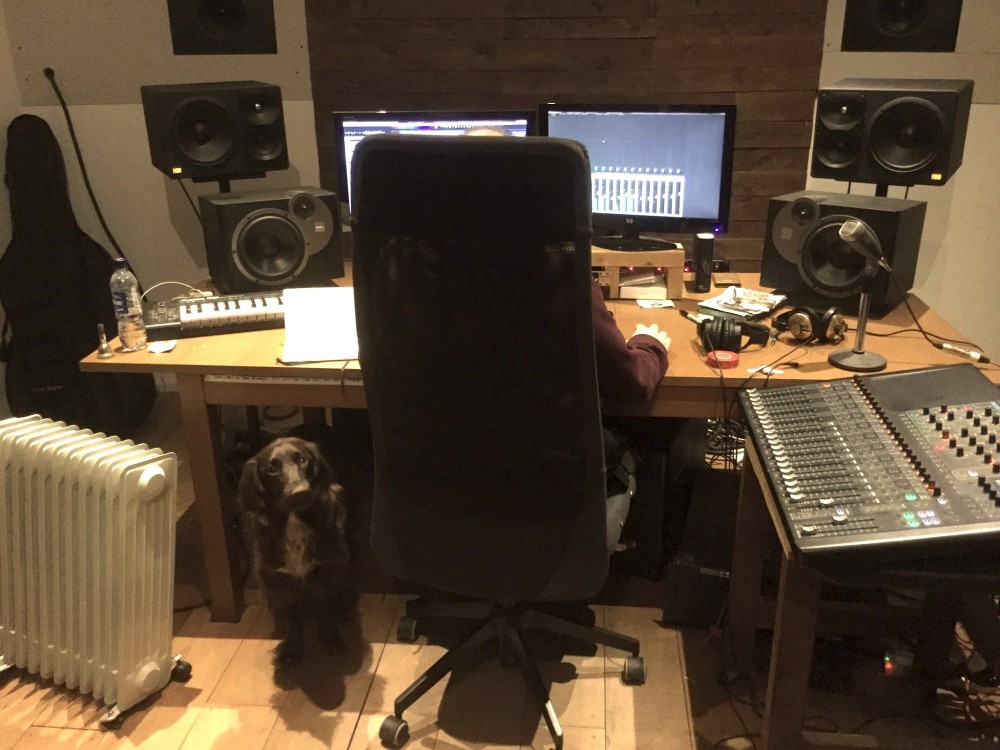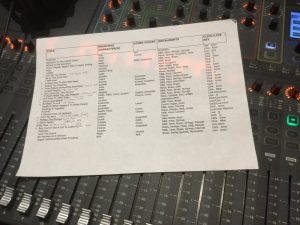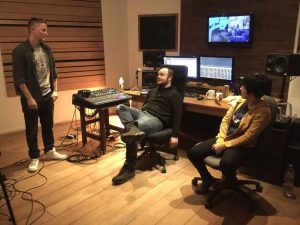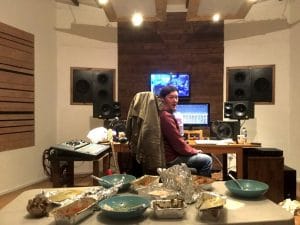
While recording my last few song collections (Bedlam Six’s Youth, Down Down Down and my solo LP Gentle Songs Of Ceaseless Horror) the production brief was always about honesty. In the case of the band albums we were trying to capture a sense of immediacy, of people sharing the same space and moment; in the solo LP the attempt was to lift the veil on quieter thoughts using simple arrangements, conjuring up a sense of personality without too much pomp. Though tonally very different, in their essence I suppose they were all preoccupied with the same thing: Truth.
One could argue that with the musical soundtrack it is very much the opposite. Here we are concerned with a work of fiction. The moment to be captured is one that never happened, the honesty is the honesty of made-up characters – indeed, depending on the character, sometimes it is the honesty of dishonesty.
Nevertheless, there is truth in everything, even fiction. One must simply find that truth and stick to it. This is where the production choices come in. They illuminate the scene: the hazy dawn spreading across the fields, the starlight in the tangled forest, the lightning over the mountains… if lyrics, melody and rhythm are people, places and activity, then the producer is the sun, moon and all the weather of the seasons.
 Over the last few years I have worked with two people very closely: Biff Roxby and Dan Watkins. We get on very well (indeed I even conducted the vows at Dan’s wedding) and getting on well is essential when one is attempting to record over thirty tracks in a relatively short amount of time.
Over the last few years I have worked with two people very closely: Biff Roxby and Dan Watkins. We get on very well (indeed I even conducted the vows at Dan’s wedding) and getting on well is essential when one is attempting to record over thirty tracks in a relatively short amount of time.
I am very fortunate that their ambitions as recording engineers have always grown at the same rate as my ambitions as a writer. When we first worked together it was with a bunch of microphones plugged into a laptop in a bedroom. Fast forward ten years and they now run their own studio: WR Audio, a space they designed and built themselves, comprising two recording areas (one of which being a huge and gorgeous-sounding live room) plus a warm and comfortable control room in which one can make all those important decisions such as the volume of cowbell and where to order takeaway when working late.
 We talked through the project a month or so before recording began and quickly agreed that, whilst we would attempt to create an album that might conceivably have been recorded in a theatre with a full cast and finite accompaniment, we wouldn’t be averse to cheating if the need arose. By this I mean that, because our musical would not benefit from the visual stimuli of light and smoke and dance to hammer home certain dramatic moments we would allow ourselves the freedom of the unrealistic overdub (eg several flute parts played by the same individual) and, where necessary, an occasionally inconsistent sonic landscape (eg an echo that is present for one singer then a moment later denied to another), all in the name of artistic license. For the most part the ensemble is static: drums, percussion, bass, piano, strings, brass and woodwind. That’s the bedrock of this record. But sometimes you want a musical saw. It’s unlikely one would have the budget to employ a saw player solely for the sake of one or two numbers but in the studio we are permitted such indulgences.
We talked through the project a month or so before recording began and quickly agreed that, whilst we would attempt to create an album that might conceivably have been recorded in a theatre with a full cast and finite accompaniment, we wouldn’t be averse to cheating if the need arose. By this I mean that, because our musical would not benefit from the visual stimuli of light and smoke and dance to hammer home certain dramatic moments we would allow ourselves the freedom of the unrealistic overdub (eg several flute parts played by the same individual) and, where necessary, an occasionally inconsistent sonic landscape (eg an echo that is present for one singer then a moment later denied to another), all in the name of artistic license. For the most part the ensemble is static: drums, percussion, bass, piano, strings, brass and woodwind. That’s the bedrock of this record. But sometimes you want a musical saw. It’s unlikely one would have the budget to employ a saw player solely for the sake of one or two numbers but in the studio we are permitted such indulgences.
 It was crucial to remember, however, that when dealing with this amount of songs, infinity is our enemy. Digital recording means one can layer up zillions of parts to create work of such brain-shattering enormity as to stupefy a listener beyond all reason. A limited palette is important, otherwise one might never finish (indeed, one might be too overwhelmed by the endless possibilities to even begin). This is where the producer comes in. A good one (or in this case a good two) knows what is best for the song and knows how to make the most efficient/creative use of the ingredients available. Biff has an incredible intuition when it comes to both musicians and their instruments, plus his sense of aural space is astonishing – indeed I’ve never known anyone with such a keen grasp of harmony (and, if the spirit moves him, chaos). This coupled with Dan’s enviable affinity with acoustics and an uncanny understanding of all things technical, makes them a formidable team.
It was crucial to remember, however, that when dealing with this amount of songs, infinity is our enemy. Digital recording means one can layer up zillions of parts to create work of such brain-shattering enormity as to stupefy a listener beyond all reason. A limited palette is important, otherwise one might never finish (indeed, one might be too overwhelmed by the endless possibilities to even begin). This is where the producer comes in. A good one (or in this case a good two) knows what is best for the song and knows how to make the most efficient/creative use of the ingredients available. Biff has an incredible intuition when it comes to both musicians and their instruments, plus his sense of aural space is astonishing – indeed I’ve never known anyone with such a keen grasp of harmony (and, if the spirit moves him, chaos). This coupled with Dan’s enviable affinity with acoustics and an uncanny understanding of all things technical, makes them a formidable team.
 Here we are telling a story that places reality and fantasy side by side, a narrative where events may not be real but they are all possible. The production needs to reflect the sensational aspects as well as the tawdry. This calls for a grasp of both art and engineering – the grand gesture and the unhurried minutiae.
Here we are telling a story that places reality and fantasy side by side, a narrative where events may not be real but they are all possible. The production needs to reflect the sensational aspects as well as the tawdry. This calls for a grasp of both art and engineering – the grand gesture and the unhurried minutiae.
A recording studio is, in some ways, very much like a theatre. They both seek to forge magic and make-believe. But here we also attempt to trap and preserve those things. And that requires all manner of devilish science. Happily for me, Dan and Biff are well-versed in this demonic lore. And Ozzy the studio dog lends a welcome sense of innocence to what is, when you think about it, a wholly unnatural thing to be doing.
BACK TO MAIN JOCASTA PAGE
Read an article about adapting the myth
Read an article about composing the songs
Read an article about writing the script
Read an article about recording the rhythm section
Read an article about recording the singers
Read an article about the orchestration
Read an article about recording the crowd vocals
Read an article about mixing the album
View photos from the Lowry showcase event
View rehearsal photos
Project Overview / Final Thoughts
And here’s a piece about being funded by Arts Council England

